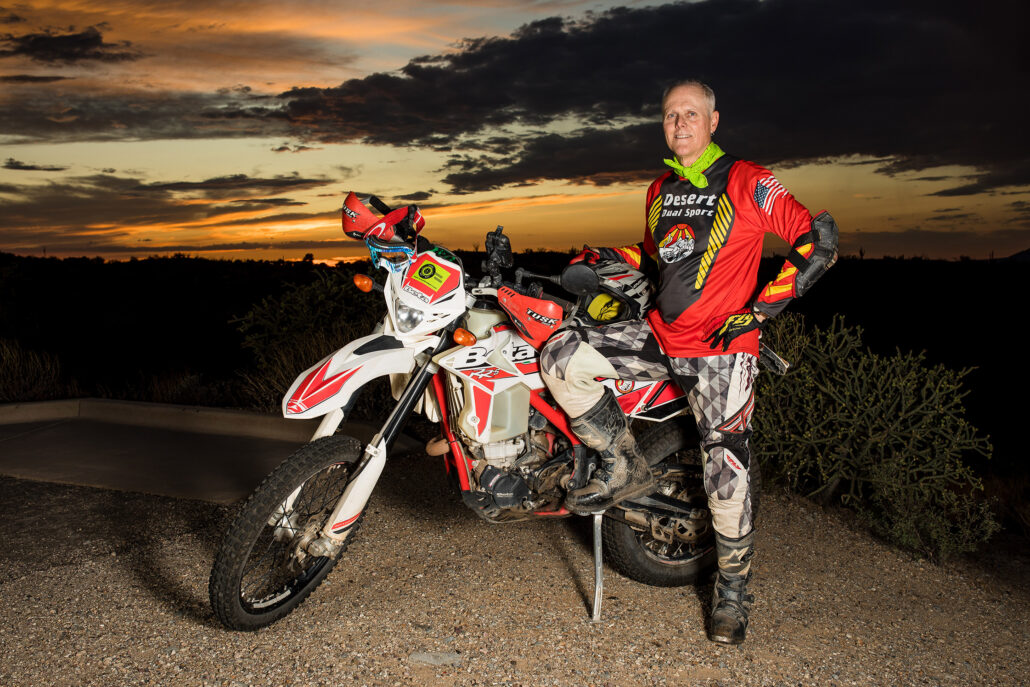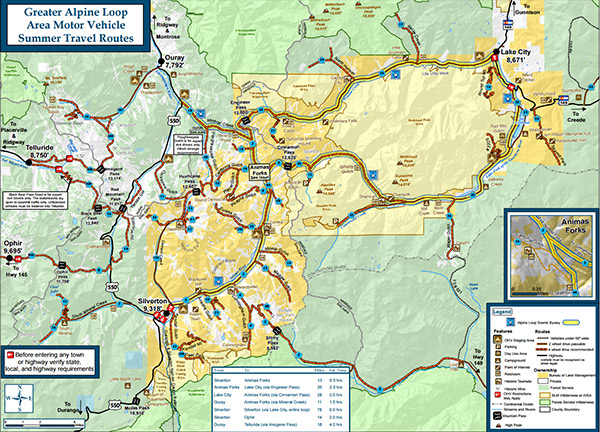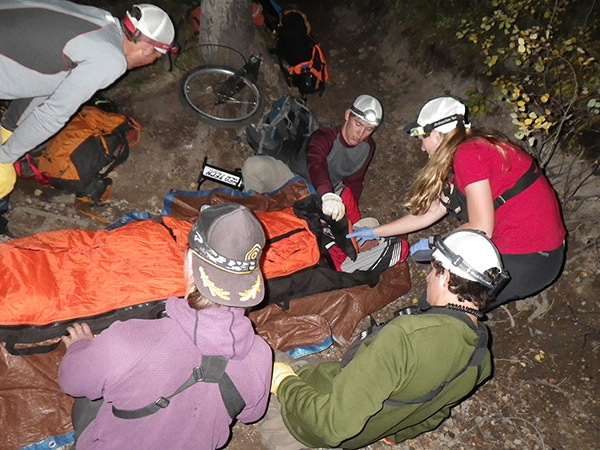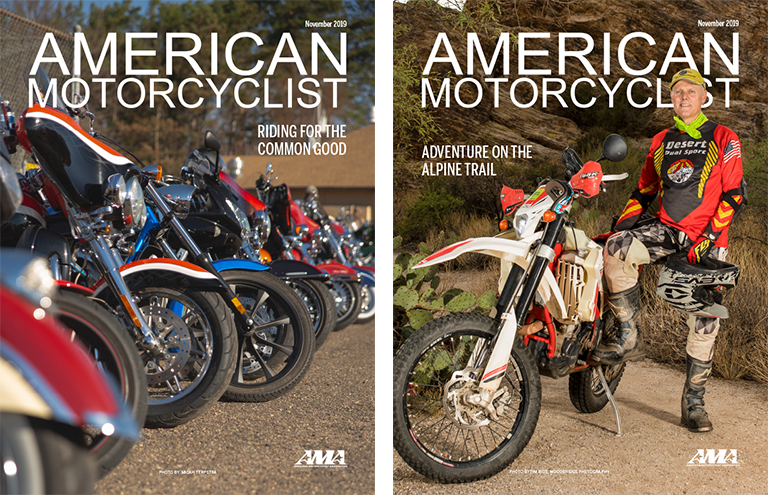AMERICAN MOTORCYCLIST November 2019
Fall In Colorado
Adventure, A Mishap, Some Lessons Learned

By Chris Dodds
The fresh, clear mountain night with a cheerful warm campfire could only be improved with a couple of steaks and a six-pack of beer.
We sat under tall pines on the steep side of a mountain on the Western Slope of the Colorado Rockies, about an hour and a half northeast of Ouray.
It was only Ron Alegria and me—no other humans in sight and no light or noise pollution to spoil the solitude.
Looking up, we saw bright stars through the tree branches. The sky was crystal clear, and the air was cold.
Surprisingly, we were not freezing, even though the temperature had dropped to 40 degrees soon after the sun dipped below the horizon. Being below the mountain peaks, we found refuge from the wind even though we were still at 10,000 feet.
Ron and I shared the few snacks we had and rationed our water to make every drop last. It was midnight, and we were relaxing around the fire and sharing stories about dirt bikes, trips we had made, friends and family.
The quiet night was suddenly shattered by sounds coming from far down the trail in the valley. Ron and I stopped talking and perked up our ears, trying to discern what was happening. The mountains in this area of Colorado have plenty of wildlife, including wolves and bears. Maybe a moose or elk?
Several minutes passed before we could make out human voices. Apparently, the Colorado Search and Rescue was on its way.
The rest of the story…
Earlier that evening, about 6 p.m., Ron had chosen this switchback on the Alpine Trail for our campfire. Well, not exactly like that. He had accidentally bump-started his bike somewhere around switchback 110 of the 140 that make up the Alpine Trail.
Ron had been coasting through the turn when the engine started and instantly launched him off the trail, down a 60-degree ledge where he came to an abrupt stop—with the help of a dishwasher-sized bolder—eight feet down from the trail. This resulted in a mangled knee, which led to our spending most of the night in the serenity of the Colorado Rockies.
We were on a four-day ride with 15 other riders but, at that point, our small group consisted of just Rick Ogas, Ron and me. Rick was leading. After the crash, we determined Ron could no longer stand or ride. Rick volunteered to ride out and get help, and I stayed with Ron.
Fortunately, Rick and Ron brought radios and Rick kept us informed of the rescue efforts as the day turned to night.
After Rick left, I got busy trying to keep us from freezing to death. I climbed down to Ron’s bike and retrieved his jacket and hat. He pulled those on. And I put on all the extra clothes I had: thermal undershirt, neck warmer, jacket and knit hat.
Ron couldn’t stand up, but when he sat still, he was relatively pain free. I gave him 600 mgs of ibuprofen from my backpack and cleared a comfortable place for him to sit. Then I began collecting wood for a fire. I always pack a lighter, so getting the fire started was no problem.
Mapping the route
I had been riding dirt bikes for almost 40 years, and this was the hardest single-track trail I had ever done. Our first two days of riding were on rugged jeep trails out of Ouray and more than 14,000-foot mountain passes into Telluride and Silverton.
It was the end of September. The leaves had turned crimson and rust orange, and the Aspens were a bright yellow. Our group organizer, Jim Kueneman, named this four-day ride “Ouray Fall Colors.” The name was spot on. Our group of 15 stopped more than once just to appreciate the magnificent colors and scenery that this area has to offer.
Before we started the Alpine Trail, we began our day on the Alpine Loop from Ouray, through Engineer Pass, to Lake City. The Alpine Loop is completely different from the Alpine Trail. Personally, I would rate the Alpine Loop as adventure bike friendly and the Alpine Trail as unfriendly—to all motorcycles and riders.
Rick had heard of a nice single-track trail that was only 15 miles long. He and Ron had tried the first several miles of it from the Silver Jack reservoir side the previous year and thought they ought to try the whole trail someday. Since then, he had researched it online and viewed it on Google Earth.
Tough trails
At 1 p.m., Rick, Ron and I began the journey to the Alpine Trail.
Rick had talked about the trail with a few people he met in town. These folks indicated it was a fun ride with great scenery and not too difficult.
Perhaps they had ridden this trail many times in the past and had become immune to its difficulty. Perhaps they were trials competitors. Whatever the case, their advice was way off for us. This was the hardest trail I have ever ridden: very steep climbs and descents, plenty of sideways rocks and slippery roots, impossible switch backs—more than 140 of them.
The approach to the uphill switchbacks was very steep, followed by a 180-degree turn, followed by a very steep continuation. I would slow down a bit, plant my foot in the elbow of the turn, lean the bike outward so the handlebars didn’t drag, then accelerate up the hill, trying to maintain momentum. I often failed and stalled my bike, which was a kickstart-only Honda XR400R.
This was a good way to overexert myself. I had to stop almost every five minutes to catch my breath. My heart was pounding, and I was dripping in sweat.
At 4:30 p.m., we began our descent to Silver Jack reservoir. The switchbacks here were so sharp, the trail makers provided a pullout, where you could stop, cock your handlebars sharply, back out, and then realign your front tire to get back on the trail. In other words, a three-point turn.
- Coming down the trail on a motorcycle was easier than hiking it.
- The rescue team at work.
- Several spouses came along for the scenery. Ron’s wife, Dawn, borrowed my gorgeous corner room to paint the mountain view from the windows while we were out riding.
The rescue
We could clearly hear the voices now, and we could look down through the thick forest and see lights. I called down to the rescue crew, who answered that they would reach us in a few minutes.
As it turned out, we were only 3 miles from the valley floor and a road.
Our cell phones didn’t work on the mountainside, but when Rick reached the bottom, he was able to call for help. He dialed 911 and was directed to the sheriff, who eventually directed him to the local search-and-rescue. He used his radio to reassure us help was on the way.
(Note: A portion of the $25 annual fee for riding Colorado trails pays for equipment and transportation costs for volunteers. You can’t get this kind of insurance anywhere else. Please be responsible and always buy the recreational sticker.)
The search-and-rescue team out of Gunnison included student and alumni volunteers from Western Colorado University. Eight young bright, strong and cheerful men and women showed up at our campsite on the Alpine Trail.
Ron had radioed Rick to stay down the hill, because there was no need for him at this point.
Immediately, one of the women took Ron’s vitals and checked his leg. Nothing was broken, but she confirmed he couldn’t stand on it. Two rescuers carried pieces of a stretcher, which they quickly assembled.
They wrapped Ron up with an insulated blanket, then put him on the stretcher and attached a tall bicycle wheel to the middle of it underneath him.
Ron was comfortable, but a bit anxious, having to rely on these folks to keep him from soaring over the edge. The track was only about 2 feet wide, with a steep slope up from the path on one side and another steep slope dropping down the other.
Six people maneuvered Ron on the stretcher. They wanted to have their grip at the same height as the stretcher, so two duck-walked on the uphill side, two slipped along the downhill side while holding him chest high, and the other two were positioned front and back.
The person in back had control of a brake for the wheel—great idea.
I was impressed by their teamwork, equally sharing the load between men and women and ready to volunteer to switch out anytime one of them needed a break.
The smallest person in their group was a woman about 5-foot, 2-inches tall and maybe 100 pounds. She had on a backpack that was almost as big as she was, and she carried it with what appear to be little effort.
When we started heading down the mountain, she strapped Ron’s 20-pound backpack to hers and hiked happily along behind the stretcher. She was the first one to switch out with one of the guys guiding the “unistretcher” while still hauling both backpacks!
These folks were hardcore.
I wasn’t sure if it was allowed, but I asked one guy if he could help me get Ron’s bike back up on the trail, so it could be ridden out the next day. He told me not to worry. He grabbed two other guys and, with a bit of struggle, they dragged and carried the bike up to the trail and leaned it on the upside of the hill. I certainly couldn’t have done it myself.
Hiking downhill on this steep trail with killer switchbacks is tougher than riding it on a cushy motorcycle. It may sound easy, going downhill, but the strong young rescuers (all less than half my age) still had a struggle.
They were constantly slipping and falling, but they held onto the stretcher while the rest kept it supported.
One section was so difficult and steep everyone came to a halt, and a couple of guys set up block and tackle to lower Ron safely. A climbing rope was wrapped around a tree, with one end attached to the stretcher. The lead guided the progress through this extra rough section of about 40 feet.
Riding on the stretcher looked like fun, but Ron assured me it wasn’t. He was securely strapped in and if they let go, he would have sailed over the edge without being able to break free. They didn’t and he didn’t, so no worries.
Amazingly, at the halfway point, there were eight more rescuers, and they switched out with the first group. Wow, these folks were gung-ho and dedicated group. They’ll take any excuse to cut class, I guess. But, seriously, our group sent out a big sincere “thank you” to the search-and-rescue team.
I was ecstatic and relieved when we reached the forest service road at the trail entrance at 3 a.m.
We got to our hotel in Ouray by 5 a.m. I slept hard that night and dreamed of single-track trails, beautiful scenery and fall colors.
Wrapping up the ride
When I awoke in the afternoon, Rick’s wife, Marci, drove us back to retrieve both Ron’s bike and my bike. The 3-mile hike up during the day was harder than hiking down the night before.
We came across three trees that had fallen across the trail.
Rick had to drag his bike over them the night before, but search and rescue had cut through them with a handsaw, so they were no longer an obstacle.
I believe hiking the trail was scarier than riding it. When you are cruising along, tunnel vision helps you focus on the path. It becomes well defined and magnetic. And the drop-offs are less intimidating. I counted the switchbacks as we hiked up to the two bikes, there were 23 of them.
When we rode the bikes down, I counted the turns again. At turn No. 20, I acknowledged there were only three left, and I felt a surge of relief overcome me. We were going to make it, and now we could relax.
At 4 p.m. on Day 3, we headed back to Ouray. “Hotel Ouray” rented out its entire place for our group.
The staff was hospitable and got permission from the sheriff for us to park our 15 bikes on the sidewalk in front of the hotel.
The hotel was remodeled a year before we arrived for our stay, and the prices were reasonable for how classy the place was—too classy for us dirt bikers, but much appreciated anyway.
On Day 4, I got up late. I slowly emerged from my deep sleep, still feeling relief that Ron had been rescued and the bikes had been retrieved.
I got dressed and walked up the street to the Wiesbaden Lodge. There is a cave beneath the lodge with some natural hot springs flowing through it.
I spent several hours soaking in the hot springs, followed by stretching my sore muscles and joints and sleeping in chaise lounge chairs in a quiet room.
This rejuvenated my body and spirit so much so that I even considered going back and riding Alpine Trail again—after taking a year or two to fully recover.
But I have learned a few things. For one, next time we will start much earlier in the day. And I might pack some extra emergency supplies as well—like maybe steaks and a six-pack.
Chris Dodds is an AMA Charter Life Member from Tucson, Ariz.





